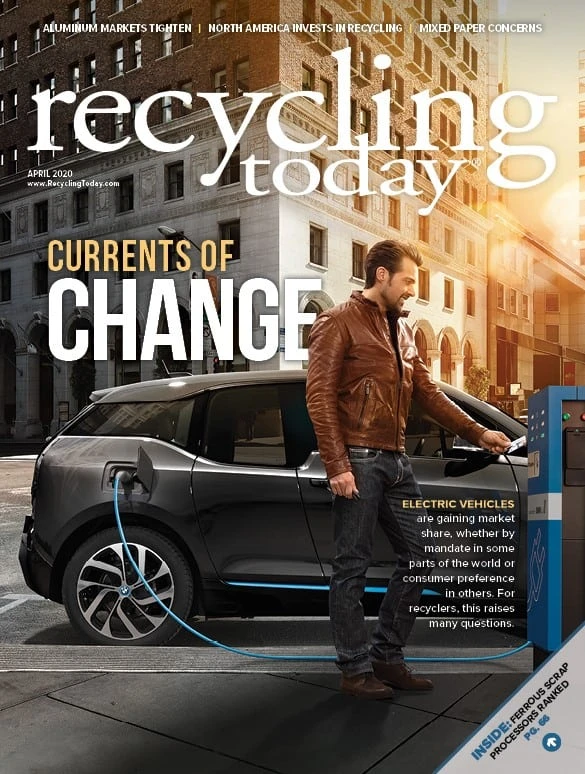Most world economies already had been shaken before the second week of March, when the World Health Organization declared the novel coronavirus, COVID-19, a pandemic. Although most markets have taken a hit and shipping containers are rumored to be scarce as a result of COVID-19, recovered paper markets are expected to fare a little better—at least in the near-term future.
Bill Moore, president of Atlanta-based Moore & Associates, says pricing for most recovered paper grades had been advancing for about 60 days as of the second week of March. “China’s buying of recovered paper was moving up and moving the market up,” he says. “The containerboard business in the globe in the last two months and in the U.S. has improved.”
“We think there will be upward pressure through the balance of this half of the year … and then we’ll see.” – Adam Josephson, equity research analyst, KeyBanc Capital Markets
The average price of old corrugated containers (OCC) rose to $44 per ton in the March buying period, according to Fastmarkets RISI’s PPI Pulp & Paper Week report released March 5.
Adam Josephson, equity research analyst at New York-based KeyBanc Capital Markets, says OCC wasn’t expected to improve this much in the first quarter of 2020. He says coronavirus-related concerns and China’s increased buying appear to be helping give this recovered paper grade a boost.
“U.S. OCC prices hit an all-time low at the end of last year. At the time, there was no reason to expect much of an upward move in 2020,” he says. “Then, coronavirus came about and that severely limited collection of used boxes in China, which led to a shortage of OCC domestically as a result of which China became ever more reliant on imports.

“The Chinese government issued a disproportionate percentage of its expected 2020 quotas in the first quarter—40 percent of its quotas in the first quarter alone,” he continues. “That led to a surge in demand in the first quarter. The impact was exacerbated by coronavirus because China had even more need for imported OCC at that point. Those two factors have combined to put upward pressure on U.S. export OCC prices throughout 2020, bearing in mind we’re not even halfway into March.”
Josephson adds that collection in China isn’t near where it used to be before COVID-19. “There are still major supply chain disruptions going on,” he says. “We think there will be upward pressure through the balance of this half of the year … and then we’ll see. This has been almost entirely driven by coronavirus, and who knows what it will be like over the next several months. No one knows.”
While OCC prices got a boost in March, mixed paper prices sank to an average of -$7 per ton in the same time frame, according to Fastmarkets RISI’s PPI Pulp & Paper Week March 5 report.
“If the economy turns down, box business will turn down and then OCC prices will turn down.” – Bill Moore, president, Moore & Associates
While prices are particularly low for mixed paper, demand could rise for this grade. In late February, Total Fiber Recovery announced plans to construct a recycled pulp production facility in Chesapeake, Virginia, which would consume mixed paper primarily.
Demand also could rise for mixed paper, sorted office paper and coated book stock with higher demand for toilet paper, paper towels and other products in March spurred by the coronavirus. “There are some increased operating rates in the tissue sector,” Moore adds.

Dan Gee, senior associate at Moore & Associates, says this near-term demand might decline in the second half of 2020. “I think a lot of paper mills will have reduced finished product demand in the last half of 2020 due to the coronavirus—less products being purchased due to a combination of the economy and coronavirus,” he says.
But economists are predicting impacts from the coronavirus outbreak could lead to a recession in the U.S. that could adversely affect recovered paper markets.
“There is a pretty reasonable correlation” between OCC and gross domestic product (GDP), Moore says. “Although the previous two years and into this year, there wasn’t such a good correlation because the economy was strong and OCC was down. But that’s the China effect. But if the economy turns down, box business will turn down, and then OCC prices will turn down.”

Explore the April 2020 Issue
Check out more from this issue and find your next story to read.
Latest from Recycling Today
- Orion ramping up Rocky Mountain Steel rail line
- Proposed bill would provide ‘regulatory clarity’ for chemical recycling
- Alberta Ag-Plastic pilot program continues, expands with renewed funding
- ReMA urges open intra-North American scrap trade
- Axium awarded by regional organization
- Update: China to introduce steel export quotas
- Thyssenkrupp idles capacity in Europe
- Phoenix Technologies closes Ohio rPET facility





